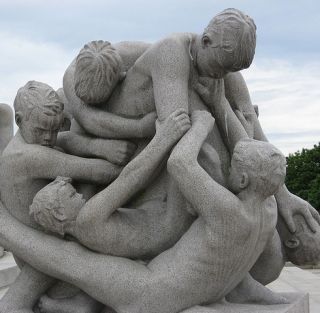Play
Do Boys Need Rough and Tumble Play?
Why do boys wrestle, roughhouse, and play pretend fighting?
Posted June 30, 2015 Reviewed by Devon Frye

If you watch a group of boys playing outside, chances are, at some point, one boy is going to leap on top of another. There will be a lot of yelling and ferocious roars, but also lots of grins. Other boys will try to pull the first boy off or grab on, too, and they'll all end up in a pile on the ground.
If there's an adult around, especially a woman, the odds are good that the adult will tell the boys, "Stop that right now before someone gets hurt!"
How Common is Rough-and-Tumble Play?
Rough-and-tumble play, also called horseplay, roughhousing, or play fighting is a common activity among children. It starts in the toddler years and becomes increasingly common until late elementary or middle school.
About 60 percent of elementary school boys say they’ve done play fighting, but this is not the only way boys play. Even among 11-year-old boys—the most frequent participants in rough play—it comprises only a tenth of what they do in their free time. Also, not every boy participates in rough play. About 40 percent of boys say they don’t like play fighting, so they tend to play other games (Smith, 2010).

Telling the Difference Between Play Fighting and Real Fighting
Research in which people are shown video recordings of boys engaged in real or play fights tends to show that it’s sometimes hard to tell these apart. Eight- and 11-year-old children were able to correctly identify the type of fighting about 85 percent of the time. Adult men were correct in classifying 70 percent of the scenes. Adult women who grew up with brothers were about as accurate as men, but women who hadn’t grown up with brothers mostly thought that all of the videos involved real fighting (e.g., Conner, 1989; see summary in Pellis & Pellis, 2012).
It turns out there are very specific differences between play fighting and real fighting (Fry, 2005; Smith, 2010). In rough play, kids are smiling and having a good time; in real fights they’re angry or crying. In rough play, kids take turns “attacking” and being “attacked” and they’re careful not to push or hit too hard. In real fights, the kids are trying to hurt each other. Rough play often involves a whole group of kids, and they continue playing together happily afterwards. Real fights usually involve only two kids, and they don’t want to be together afterwards.
The Appeal of Rough Play
The appeal of rough play is the physical challenge of testing their strength and the exciting idea of being powerful. Among young boys, roughhousing often involves pretending to be superheroes or good guys and bad guys.
Adults, especially women who aren’t personally familiar with rough play, often try to stop roughhousing because they don’t want anyone to get hurt. But research tells us that, overall, rough play turns into a real fight only about 1 percent of the time among elementary school boys (Smith, 2010).
In order to have fun with rough play, kids need to know how to do it right—to keep it light by taking turns, not being too rough, and not overreacting or getting offended when there's no mean intent. Usually, it’s kids who have trouble with self-control who end up causing injuries in rough play. Children who are rejected by their peers get overly aggressive in about one-fourth of roughhousing episodes (Pellegrini, 1994).
Kids who get out of hand with roughhousing may benefit most from "coaching" in supervised rough-and-tumble play. Intriguing research by neuroscientist Jaak Panksepp shows that giving young, hyperactive kids lots of opportunity to play fight helps them learn to inhibit their behavior. If your child has trouble being too rough, it may help to practice play fighting with a parent. Be sure to end with the parent being gently but firmly dominant.
If you're not sure whether your kids are engaged in a play fight or a real fight, ask, "Is everyone having fun?" If not, they need to stop. For your own peace of mind, it's fine to insist, "That's an outdoor game!" You may also want to set up a code word that your kids can use to call a stop to the action. "No," "Stop," or "Don't" aren't good code words because they can be part of the play. Help your kids choose an off-topic word, such as "Bananas." When someone says the code word, everyone has to let go and move back.
During the adolescent years, play fighting becomes less innocent (Fry, 2005). From about age 11 onwards, rough play has an underlying theme of establishing a dominance hierarchy. Boys tend to challenge other boys whom they perceive as slightly weaker. If the weaker boy quickly expresses distress, the fighting becomes more playful. If he doesn’t give in right away, both boys may behave in increasingly aggressive ways until there’s a clear winner.
Among tween and teen boys, rough play is most common in a new group, where the boys don't know each other, and it becomes less frequent once a dominance hierarchy is established. Tweens and teens need adults to act as safety railings, allowing their high-spirited play, but making sure they don't go too far and end up seriously hurting each other.
Did you do rough play as a child? Do you think, as a society, we've become too restrictive of rough-and-tumble play, or are we not restrictive enough?
Related Posts
Making Up is Hard To Do…For Kids
Growing Friendships blog posts are for general educational purposes only. They may or may not be relevant for your particular situation. You’re welcome to link to this post, but please don’t reproduce it without written permission from the author.
© Eileen Kennedy-Moore, Ph.D.
References
Conner, K. (1989). Aggression: Is in the eye of the beholder? Play & Culture, 2, 213–217.
Fry, D. P. (2005). Rough and tumble social play in humans. In A. D. Pellegrini & P. K. Smith (Eds.), The nature of play (pp. 54–85). New York, NY: Guilford Press.
Paquette, D., Carbonneau, R., Dubeau, D., Bigras, M., & Tremblay, R. (2003). Prevalence of father-child rough-and-tumble play and physical aggression in preschool children. European Journal of Psychology & Education, 18, 171-189.
Panksepp, J. (2007). Can PLAY diminish ADHD and facilitate the construction of the social brain? Journal of the Canadian Academy of Child and Adolescent Psychiatry, 16, 57-66.
Pellis, S. M., & Pellis, V. C. (2012). Rough-and-tumble play: Training and using the social brain. The Oxford Handbook of the Development of Play. Online version. DOI: 10.1093/oxfordhb/9780195393002.013.0019
Smith, P. K. (2010). Children and Play. (Chapter 6: Physical Activity Play: Exercise Play and Rough-and-Tumble.) Chichester, UK: Wiley-Blackwell




